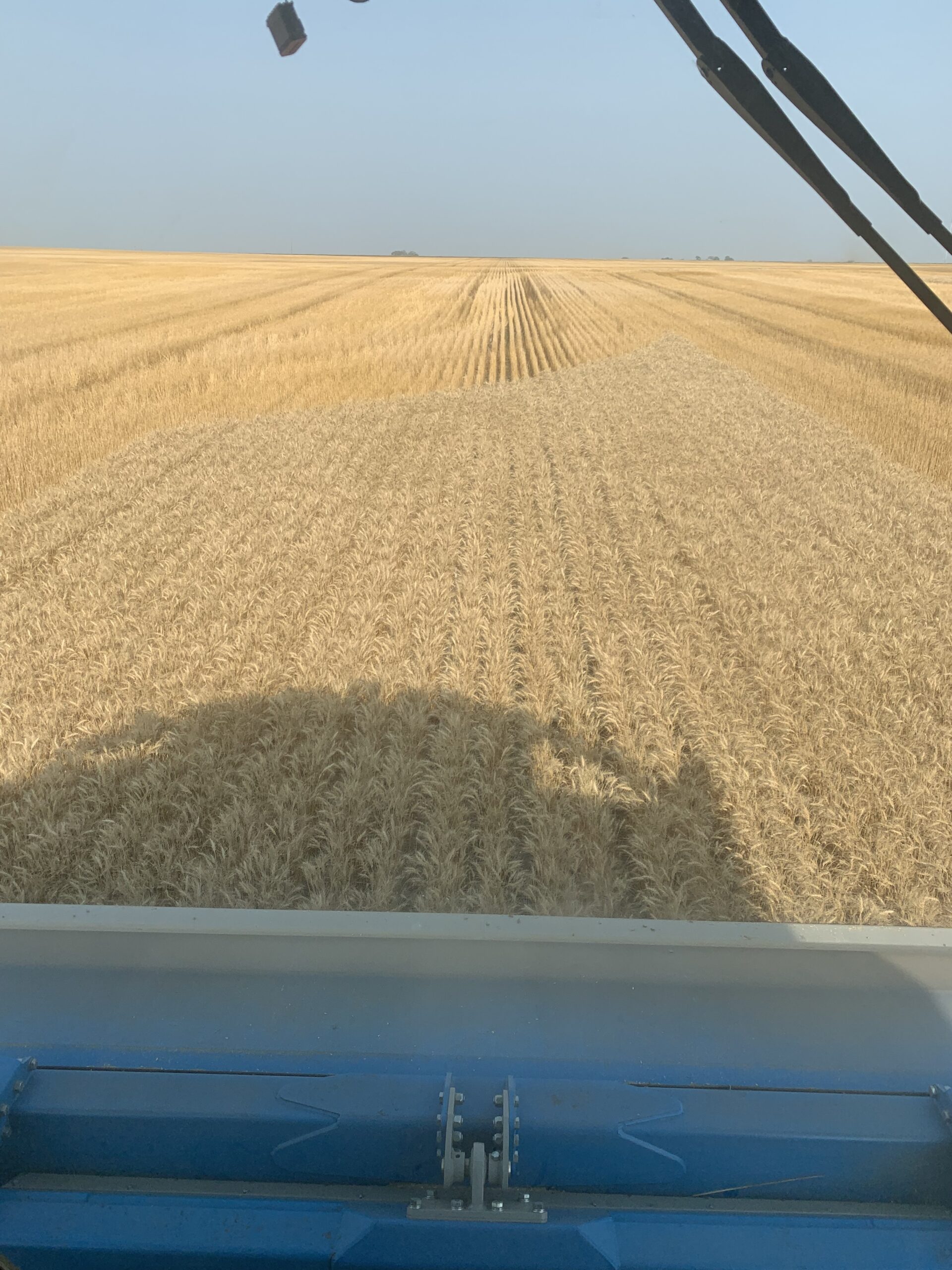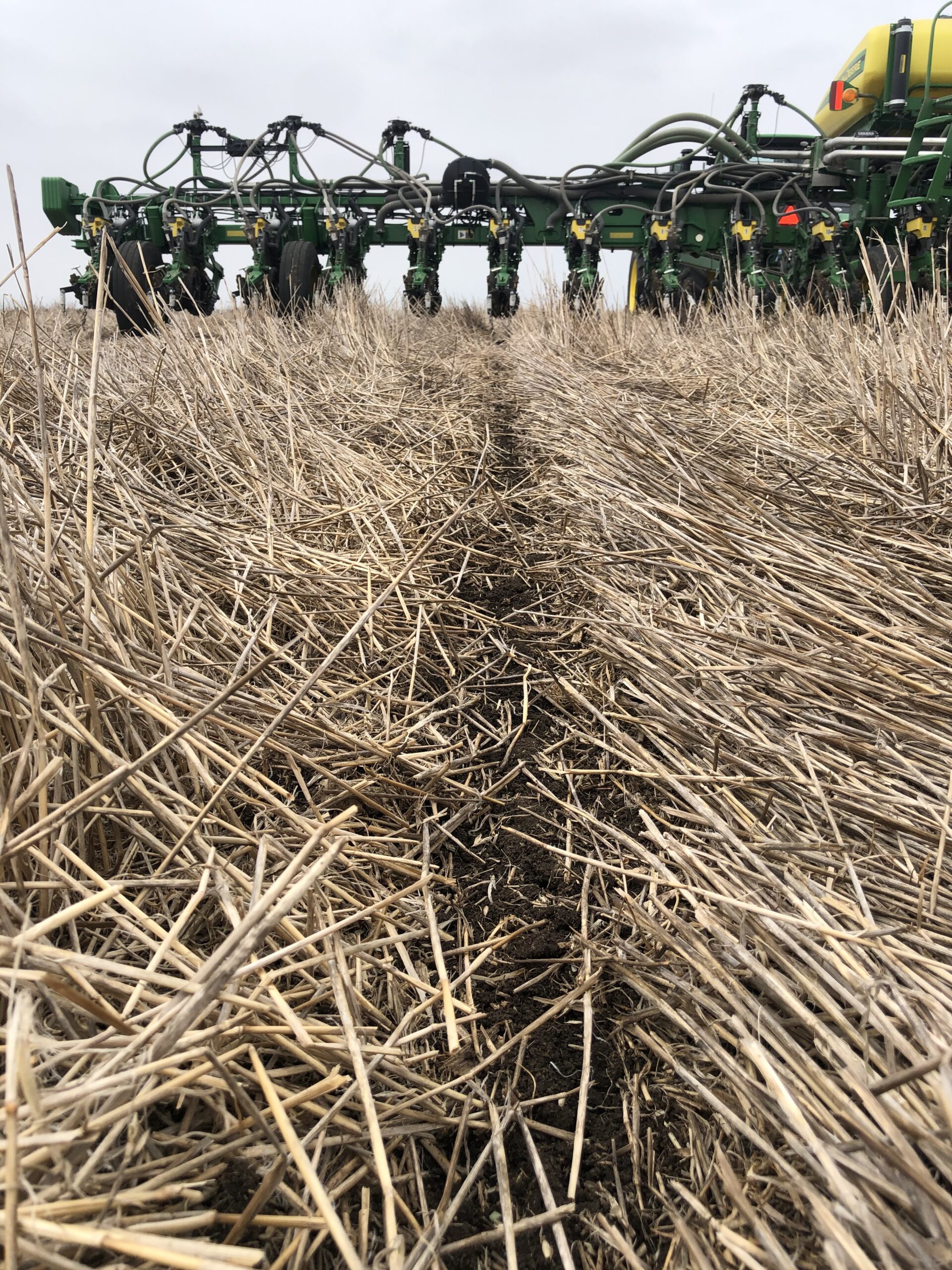
Cronin Farms uses stripper combine heads to harvest wheat in order to leave behind useful stubble which will protect the soil, aid moisture retention, and build soil organic matter. Courtesy photo.
By Stan Wise
PIERRE, SD – When Cronin Farms partner Tregg Cronin takes the long view of his operation, he knows that including a small grain in his rotation can lead to higher profitability.
“Consistently we see a yield bump following that year of wheat and, in our case, following those two years of wheat,” Cronin said. “When you look at it as a system over a three- or five-year time frame, for us especially, the net returns on that whole system almost always outweigh just a simple corn-soybean rotation.”
Cronin Farms near Gettysburg, SD, employs a diverse rotation including corn, soybeans, spring wheat, winter wheat, oats, sunflowers, alfalfa, a forage blend and cover crops.
Cronin said that last year was a good example of a yield advantage following a small grain. He said that in 2022, corn yields in his area often varied by crop rotation.
“In my immediate neighborhood, we saw differences on corn of 20 to 50 bushels an acre, depending on the rotation that the farmer implemented,” he said. “So, if it was corn on soybean stubble, in a simple corn-soybean rotation, some of those yield differences between a field like that and a field of corn planted on two years of wheat stubble, it was as much as 50 bushels an acre. And so, when you start looking at a 50-bushel yield advantage at $5, $6 – in some cases, depending on when you sold it – $7 corn, all of a sudden, yeah, that wheat didn’t really drag on your farm, and in fact, it probably made your year.”
Increased corn yields aren’t the only reason the Cronins plant small grains.
“The big benefit for us, I mean, right off the bat is always moisture retention,” Cronin said. “That stubble, as you know – most people know by now – it does such a great job of keeping the soil a lot cooler, which reduces evaporation, and especially in the central and western part of the state where moisture is almost always our limiting factor.”
Cronin believes that a diverse rotation is just as important as no-till practices when it comes to building soil organic matter. After years of soil health management practices, Cronin Farms has built healthy soils that help them perform well in the good years and weather the bad years.
“When all the stars line up and you’ve got that healthy soil that’s really working for you – you’ve got that extra organic matter or you’ve got that available organic matter – it kicks into gear, and that’s where you see the top end yields that exceed your goal by 10, 20, 30, 40 bushels an acre in some cases,” he said. “Even in a tough year, in a drought year like 2021, we still had fields where I know we add more yield than what we should have based on the rainfall we had because, again, our soils have added water carrying capacity. We’ve got the residue in place to hold what we do get.”
Cronin said that the state is already entering 2023 short of soil moisture and that water will be important in planting decisions.
“I think dry conditions are going to be on the forefront of every farmer’s mind going into this growing season,” he said. “So, if dryness is your overarching factor, it’s going to take a lot less water to raise a wheat crop than it is corn or soybean.”
Another big reason to plant a small grain, Cronin said, is the opportunity to break up the season’s workload.
“Corn and soybean farmers in the spring, you try to get everything done in a two-week window, and then the same holds true in a lot of cases in the fall. You’re trying to get all this harvest done in a very small window,” he said. “Whereas, if you’ve got spring wheat harvested in the bin by the middle of August, well, that’s one less thing that you have to deal with come September, October.”
Cronin said that wheat prices are relatively high right now, but before growers decide to plant spring wheat for the first time, they need to have some marketing plans in place.
“What I see, a lot of times, the producer tries something for the first time, and they really haven’t thought about: ‘Where do I get rid of this? How do I get rid of it? When do I get rid of it? What are the quality considerations that I need to meet in order to market this effectively?’ And so then they end up with a product that they can’t just haul 5 miles down the road to their local elevator and sell,” Cronin said. “So, I think you really need to look at that marketing task and how you’re going to get rid of it – working with somebody who understands those markets, who can give you some better transparency on where those markets are so that you don’t get picked off because you don’t know any better.”
For more information about adding small grains and other crops to a rotation, contact the South Dakota Soil Health Coalition at (605) 280-4190 or sdsoilhealth@gmail.com.
Download a printer-friendly version of this article.

Cronin Farms plants directly into stubble left by their small grain crops. This crop residue protects the soil, aids moisture retention, and builds soil organic matter. Courtesy photo.
0 Comments